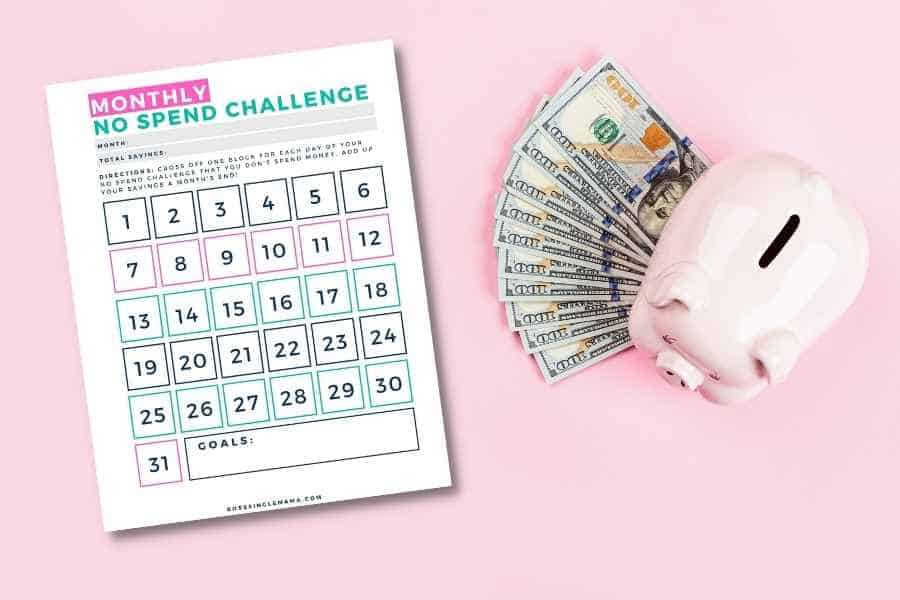Last Updated on December 30, 2022 by Rebecca Lake
Tired of feeling like you’re bleeding money all the time? Completing a no spend challenge can be a great way to get your finances back on track.
A no-spend challenge is a savings challenge in which you commit to not spending money for a set period of time. Also called a spending freeze, the goal is to cut out unnecessary spending and give you some perspective on where your money’s going.
If you’re struggling with credit card debt or bad spending habits, a no spend challenge is one of the simplest ways to hit the reset button on your finances. And you might be surprised by all the newfound savings that suddenly appear in your budget when you make a committed effort to control spending.
Keep reading for tips on how to improve your financial situation by taking a no spend money challenge.
Related post: 200 Envelope Challenge (Save $5,100 in 200 Days!)

LIKE FREE MONEY?
Here are some of my go-to apps for earning extra cash!
Survey Junkie. Earn up to $50 per survey just for sharing your opinions.
Swagbucks. Make money by playing games and watching videos. Join for free and get a $10 bonus when you sign up!
InboxDollars. Take surveys and get paid, no special skills or experience required!
Rakuten. Earn up to 40% cash back at hundreds of retailers, online or in stores. And get $30 for each person you refer, along with a $10 sign up bonus!
CashApp. Need a simple app for sending and receiving money? Get $5 free when you use code ‘VZXRXZN’ to join CashApp.
What Is a No Spend Challenge?
A no-spend challenge or spending freeze means you challenge yourself to not spend unnecessary money for a certain time frame.
You can still pay your monthly bills during this time period. But you wouldn’t spend anything on non-essential items, like your new clothes, your regular stop at your favorite coffee shop or impulse purchases at the grocery store.
At the end of the challenge, you should have extra money left in your budget if you’ve committed to curbing discretionary spending.
You can then use the money saved from the challenge to fund your financial goals.
For example, you might make an extra payment toward high-interest debt. Or you could deposit the money into your savings account to grow your emergency fund.
Related post: 100 Envelope Challenge Explained (Free Printable Chart!)
How Does a ‘No Spend’ Challenge Work?

Taking a no-spend challenge means avoiding non-essential spending for a set amount of time.
You choose the start date and ending date for your spending challenge. For the duration of the challenge, you don’t spend money on anything extra.
That means no spending with debit cards, bank account transfers, gift cards, credit cards or cash. And that includes cutting out online shopping.
You can still pay bills, like car payments, housing payments or utilities. And you’ll want to keep up with credit card debt repayment as well to avoid late fees.
But you’d replace spending money on things like date night or movie night out with free activities.
Related post: How to Do the 50 Envelope Challenge (Printable Envelope Savings Challenge Tracker!)
Why Do a No Spend Challenge?
Completing a no-spend challenge can be a great idea for several reasons. You might consider a no spending challenge if you:
- Want to spend less money each month
- Have a clear goal that you’re trying to achieve (like saving for a new car or another big-ticket item)
- Feel like you’re stuck in the paycheck to paycheck cycle
- Have a hard time tracking your own spending
- Know that you have some bad habits you want to change
Taking a no-spend challenge can help you improve your finances, a little bit at a time.
For example, cutting out $50 in unnecessary spending is $50 more that you have to save or pay down debt. And as you pay down high-interest credit cards, your credit score may improve.
Making small changes can increase the amount of money you have to reach your financial goals. And that’s a good thing if you’ve been plagued by money stress.
Related post: 50 15 5 Rule: How to Save More and Spend Less
How to Do a No Spend Challenge
If you’re considering a no-spend challenge for the first time, it helps to know what the ground rules are.
The good news is that there isn’t just one right way to do the challenge. You can tailor a no-spending-money challenge to your situation and create your own rules.
There are a few things you’ll need to do before starting a new challenge:
- Decide how long the challenge will last
- Choose which expenses you’ll cut out (and what spending is allowed)
- Get your family members on board
These pro tips can help you set your no spend challenge rules.
Step 1: Choose a time frame for your no-spend challenge
How long should a no-spend challenge last?
You might be thinking there’s a set number of days you need to commit to. But that’s not true.
Depending on your situation, a no spending challenge might last:
- One full day
- A weekend
- One week
- A whole month
- An entire year
So is it better to choose a shorter or longer challenge?
A no-spend day or no-spend weekend can be a good way to familiarize yourself with this kind of money challenge.
It’s enough time to get a handle on how much wasteful spending you might actually be doing. Trying to go cold turkey on non-essential spending for an entire month, on the other hand, could be overwhelming.
Once you’ve done some shorter money challenges, you could try month-long challenges instead.
For example, you might try a no-spend January, a frugal February or a no-spend November. Any of them could be the perfect time for a no spend month challenge for different reasons.
For example, February is the shortest month so it might be easier to commit to no spending for just 28 days. And doing a no spend November means you have a month to save extra money ahead of the major holidays when you’re more likely to spend, spend, spend.
Again, the beauty of a no-spend challenge is that you can decide what works best for you.
Step 2: Decide what to cut (and what to keep)
Once you’ve nailed down the time period for your spending challenge, the next step is deciding what you will or won’t spend money on for the duration of the challenge.
Generally, the kinds of things you can still allow yourself to spend money on include:
- Monthly bills (rent/mortgage, utilities, insurance, etc.)
- Debt repayment
- Necessary gas
- Necessary food (to make meals at home)
Anything that isn’t a “need” is something you’d cut out during your no spending challenge.
So you wouldn’t spend money on things like:
- New clothes
- Entertainment
- Hobbies/recreation
- Happy hour or coffee shop visits
- Special occasions
- Big-ticket items
- Online shopping
- Hair/nail services
- Toys or books
And that goes for all of the family members in your household.
So if your kids like spending money on video games, for example, they’d have to hit pause on those purchases. And you’d only do free things for fun until the challenge ends.
Some people will take things a step further and add groceries to the no spend list.
And considering that a typical family of four spends anywhere from $561 to $1,285 on groceries each month on average, that could actually be a great way to save a nice chunk of money.
If you’re going to cut grocery spending out during your no-spend day, no spend weekend or no spend month, here are a few pro tips for making it work:
- Plan meals. Meal planning can save you money on groceries on a regular basis since you’re only spending money on items you build into your family’s menu. And you can use meal planning to avoid unnecessary trips to the grocery store during a spending challenge.
- Make meals ahead. Freezer meal recipes can be your best friend during a no-spend challenge. You can make meals the week before your challenge starts, then pull them out for dinner as you go. (Bonus points if you incorporate cheap foods into your meals!)
- Shop your pantry. You might be surprised at how many meals you could make right now based on what’s in your pantry or freezer. While you’re challenging yourself not to spend, also challenge yourself to make use of the foods you have on hand.
Those are all simple ways to avoid spending much money (or any money at all) on groceries while you’re doing a money challenge.
Related post: 35 Ways to Save Money on Food (Without Coupons)
Step 3: Get your family on board
A no spend challenge works best when all family members understand the ground rules and agree to stick to them.
If you’re ready to try this spending challenge, a family meeting is a great way to talk about how it’s going to work. You can also discuss why you want to do it.
This can also be a great opportunity to discuss budgeting with kids. Even younger kids can grasp concepts like needs versus wants and what it means to save money.
You could even set a money goal together as a family for the extra money you hope to save by doing the no spend challenge. That could be a great incentive to keep kids interested in the challenge.
Bonus tip: Avoid the temptation to spend
You might start a no spend challenge with the best of intentions. But it can be all too easy to buy things without thinking.
Unplugging from social media during the challenge means you’re not bombarded by ads or seduced by FOMO.
You can also unsubscribe from any store mailing lists you might be on so you’re not tempted to take advantage of any special coupons or deals that might show up in your inbox.
What to Do With the Money You Save From a No Spend Challenge

The whole point of a no-spending challenge is to save money. So it’s important to think about what you’ll do with any extra cash you have at the end of the month (or week or weekend).
Setting up a high yield savings account could be a good idea if you think you’ll do no spend challenges on a regular basis.
You can deposit your savings from each challenge, then continue adding to your account the next time you do a spending freeze.
If you’re looking for a high yield savings account, check out Savings Connect from CIT Bank. You’ll get a great APY for your money without high fees.
Aside from saving, here are some other no spend challenge ideas for what to do with extra money:
- Use it to pay off credit card debt
- Make extra payments to student loans or auto loans
- Add it to your sinking funds
- Invest it for the future (start investing with M1 Finance with just $100!)
- Donate it to charity
Related post: Save Money Live Better (20 Easy Ways Save More This Year)
Printable No Spend Month Challenge Tracker
Want a simple way to keep track of your no spend progress? Scroll down to snag this free printable no spend month challenge tracker!

Make Extra Money to Save for a No Spend Challenge
Doing a spending freeze means you agree not to spend money but there’s no rule saying you can’t make money during this time.
There are so many side hustles you can start to make money, many of which you can do from home. And the more you earn from side jobs, the more you’ll be able to save, pay down debt or reach another money goal!
If you’re looking for some side hustle ideas, here are some proven ways to make extra money:
- Find things to sell for money around the house
- Share your opinions with Survey Junkie (earn up to $50 per survey!)
- Become an online test subject
- Get paid cashback when you shop with Rakuten or Ibotta
- Try some free money hacks or learn how to flip money
- Get paid to write online
- Become an online proofreader
- Apply for online transcription jobs
- Offer virtual assistant services
Those are just some of the ways you can make money in your spare time.
Related post: 142 Legit Side Hustle Ideas to Make Extra Money (Updated)

Final thoughts on taking a no spend challenge
Challenging yourself to not spend money for a set period of time can be the best way to hack your budget and stop overspending. Even if you only go one full day without spending, that’s a step in the right direction if you’re hoping to improve your financial situation.
Have you done a no-spend challenge yet? If so, head to the comments and tell me about it!
Don’t forget to check out my favorite Smart Money Tools for making and saving money before you go.
Need more ideas for saving money? Read these posts next:
- How to Save 10000 in a Year [Simple Tips That Really Work!]
- Penny Savings Challenge Explained (Save $667.95 This Year the Easy Way!)
- 52 Week Money Challenge (How to Easily Grow Your Savings)
- 23 Free Money Saving Charts to Help You Crush Your Savings Goals!
- 37 Helpful Money-Saving Hacks for Living on One Income
